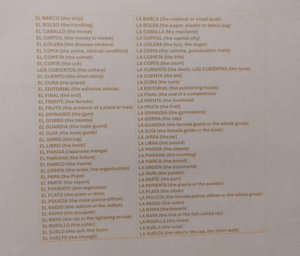![]() Here are all the rules to know when Nouns are feminine or masculine. Read them carefully, and then take one by one and practise using these words along with the articles, until they become second nature. If you are doing your GCSE’s, you will discover that nobody teaches you this, and as a result, you are not able to decide about the gender of words, and you are struggling most of the time. So pay attention!
Here are all the rules to know when Nouns are feminine or masculine. Read them carefully, and then take one by one and practise using these words along with the articles, until they become second nature. If you are doing your GCSE’s, you will discover that nobody teaches you this, and as a result, you are not able to decide about the gender of words, and you are struggling most of the time. So pay attention!
-The basic rule: words ending with -a are feminine (la puerta) and words ending with -o are masculine (el piso).
-Fake exceptions: la discoteca, la fotografía, la motocicleta, la radiofonía. We are lazy, so we say “la disco, la foto, la moto, la radio”. They are abridged feminine words.
-Real exceptions: la mano, la soprano, la modelo. They are feminine ending with -o. El día, el mapa, el sofá, el pijama, el planeta. They are masculine ending with -a.
-Words ending with -e are sometimes feminine (la gente) and sometimes masculine (el puente). So when you see a Noun ending with -e, study it with the article.
-We have a group of Nouns ending in -ma which are masculine, because they have Greek origin and do not follow Spanish rules. See all of them in blog 24, called “Masculine Nouns ending in -a”.
-Days, months and cardinal points are always masculine. So, say “el lunes, enero es frío, vivo en el sur de Londres”.
-Numbers and colours are always masculine, because “el número” y “el color” are masculine words. For the same reason, letters are always feminine, being “la letra” a feminine word. So, say “el número uno, el color rojo, la letra B”.
-Nouns ending with -sión, -ción, -xión are always feminine: la televisión, la canción, la conexión.
-Nouns ending in -aje are always masculine: el viaje, el pasaje, el personaje.
-Nouns ending in -ad are always feminine: la ciudad, la universidad, la sociedad.
-Nouns ending in -or are masculine: el olor, el dolor, el amor. We have two exceptions here: la flor, la labor.
-Nouns ending in -ez are feminine: la niñez, la vejez, la rapidez. There is only one exception: el juez, because he is a man.
-Nouns ending in -ud are feminine: la altitud, la latitud, la longitud. There is only one exception: el alud, because it is not a Spanish word.
-Nouns ending in -ista are the equivalent to those ending with -ist in English, like dentist/dentista or economist/economista, and they are used to talk about professions or activities. They always end with -a, although we can be talking about a man or a woman. So, “la dentista es muy buena”, “el dentista es muy bueno”.
-Epicene Nouns: you probably don’t know the English word “epicene”. It is a technical word that linguists use for Nouns that have only one grammatical gender. It is very common for animals in Spanish: la jirafa could be male or female, but the word remains in this form. Some epicene Nouns are: la persona, la víctima, el miembro. Never change neither the article nor the final letter: “la víctima es una mujer”, “la víctima es un hombre”.
-With some Nouns, we change the article but not the final letter: el o la colega, el o la espía, el o la astronauta, el o la atleta, el o la políglota, el o la testigo, el o la piloto.
-When talking about some cultures or civilisations, like “los mayas, los aztecas, los incas, los celtas, los persas, los indígenas”, we have masculine forms, even though they end with -a. So, say “la civilización maya” but “los mayas”, and so on.
-Fruits tend to be feminine (naranja, manzana, almendra, ciruela, cereza, etc.), but trees are masculine (naranjo, manzano, almendro, ciruelo, cerezo, etc.). So, for example “ciruela” is plum, but “ciruelo” is plum tree.
-For plantations, it is frequent to see the ending -al. These words are masculine: el cafetal, el cañaveral, el maizal, el trigal, el robledal, etc.
-Nouns starting with accentuated “a”: to avoid saying “a-a”, which is a very unpleasant sound for us, we use the masculine article, although these words are feminine. That’s why we say “el agua” and not “la agua”. More examples are: el aula, el alma, el ala, el área, el ancla, el hacha (remember that “h” is totally silent, so it doesn’t affect the sound). However, when these words are in the plural, we revert to the feminine article: las aulas, las almas, las alas, las áreas, las anclas, las hachas.
Did you see? There is a dramatic difference when you really know. Now, you can apply all these rules and you will be right about the gender of words. To finish with this topic, there is a group of words that have a totally different meaning depending on the gender, for example “el puerto” (the port) and “la puerta” (the door). Here is the list.

